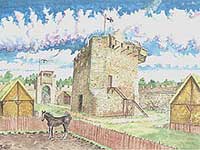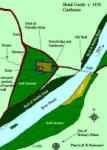 | Introduction | The Castles | Images | Links | History Of Caithness | Glossary | A to Z of Caithness |
• Reconstruction Paintings • Ground Plans • Area Plans • Photo Galleries • Non-Caithness Castles Paintings |
| Braal Castle, Caithness Map Ref: ND 137601 Landranger Sheet 12 - Link
Braal Castle Photo Gallery Introduction
In 1450, James 2nd bestowed Brathwell (or Braal as it became known later,) upon Sir George Crichton, the High Admiral of Scotland along with the Earldom of Caithness. Sir George had already inherited Dunbeath Castle from his mother at this time but Braal reverted to the Sinclairs upon his death in 1455. The tower is a rectangular structure built of rubble, still standing to the top of the second storey with walls 8 to 10 ft in thickness. The keep measures 35ft by 37ft externally. The entrance door is in the SW angle at first floor level and would probably have been approached by a detachable and retractable timber stair. The basement is unvaulted and contains no external door - access being by trapdoor from the room above. The only wall openings in the basement are two narrow loopholes with wide internal bays, arched over. The hall was on the first floor measuring 22ft by 19ft and was lit by small wide-arched windows with stone seats in the ingoes. There is also a garde-robe (toilet) in the thickness of the wall. The upper floor is reached from a straight staircase from the ingoe of the entrance doorway in the thickness of the SW wall, at the top of which there would have been another access leading to a parapet walk. Unfortunately the battlements have now disappeared but the artistic reconstruction by Andrew Spratt shows how the castle would have looked in its prime. Notice the defensive hoarding, shown here under construction, which allowed defenders to drop material upon attackers at the base of the keep.
Braal was once occupied by the Sinclairs who started to build a more commodious structure about 100 ft by 50 ft at a later date, almost adjacent to the castle. This however was never completed above the vaults and it stood like this until 1856 when a new house was built upon them and became a hotel, which I believe, is now being converted into flats. It is perhaps fortunate that the second structure was never built as the stone from the original Braal castle would almost certainly have been used in the construction and this gem of a castle would not have survived to this day. References:
|









